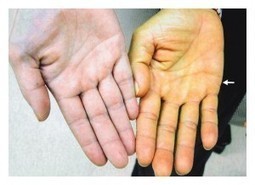Green Children of Woolpit 3: Why Green Skin? January 24, 2015
Author: Beach Combing | in : Medieval , trackbackOf the green children of Woolpit William of Newburgh writes: Ex his fossis tempore messis, et occupatis circa frugum collectionem per agros messoribus, emerserunt duo pueri, masculus et femina, toto corpore virides, et coloris insoliti, ex incognita materia veste operti. John Clark translates this, in his recent brilliant essay, as: ‘Out of these ditches, at the time of harvest when the harvesters were busy gathering the crops in the fields, there emerged two children, a boy and a girl. ‘Their bodies were all green, and they were dressed in clothing of an unusual colour, made of unknown material.’ Our second source for the green children Ralph of Coggleshall gives us, instead, these words: ‘Inventus est puer quidam cum sorore sua ab accolis loci illius iuxta oram cuiusdam foveae quae ibidem continetur, qui formam omnium membrorum caeteris hominibus similem habebant, sed in colore cutis ab omnibus mortalibus nostrae habitabilis discrepabant. Nam tota superficies cutis eorum viridi colore tingebatur.’ Again there follows J.C.’s translation: ‘A boy was found, with his sister, by the inhabitants of that place, near the mouth of a certain pit that is situated there. In the shape of their whole bodies they were like other people, but they differed in the colour of their skin from all the mortal inhabitants of our world; for the surface of their skin was all coloured with a green hue.’
The word for green here is, in both cases, the obvious Latin choice viridis: though note that Ralph also uses the word ‘prassinus’ which JC translates as leek-coloured. John Clark points out in his essay that colour boundaries vary between societies. However, given the wider medieval English use of virides we can be fairly certain that both writers meant green. Whether this was light green, dark green or day glow green is beyond guessing and probably was not clear in the mind of the writers. It is difficult, though perhaps not impossible, to imagine oral tradition inventing the green-ness of these children: there are not clear folklore associations with green interestingly, despite our modern obsession with vegetation and green fairies. A recent article on green in the Green Knight, for example, concluded that there was no obvious ‘meaning’ behind the colour.
So we have children, found in a pit, coloured some shade of green: this much is secure. What on earth is happening here? JC has helpfully gathered together the various explanations thus far put forward for green bodies. (i) Arsenic poisoning (which doesn’t though make people green, whoops); and (ii) chlorisis (hypochromic anemia), a nineteenth-century diagnostic term which, despite the promising name, does not, JC reports, colour people green either. Whoops again.
A couple of thoughts before throwing the question open to readers. First, JC makes much of the use of virides (and prassinus) in terms of a strong green. This seems too much. We can trust oral tradition in as much as, say, sixty years before a green girl and boy turned up, but can we seriously trust oral tradition to transmit the shade of green accurately?! In other words, while Ralph and William might be transmitting local tradition here, local tradition cannot be trusted for help in terms of the colour spectrum and any resulting medical diagnosis.
Second, perhaps John is a little too harsh with chlorosis, which in the end is just a Victorian taken on anemia. Anemia does create extreme pallor and extreme pallor is suggestive of a light green (‘green about the gills’ etc): is this cultural or colour-based, certainly extreme pallor makes Beach think of green?* Online there are examples of people who are described as having green skin through dietary eccentriticities. JC points out that people in Woolpit would have had children with this condition (anemia was common) and so they would have recognized fellow sufferers. But the Woolpitters were seeing things through a rather peculiar filter. Superstitious medieval peasants had just found two young children (according to William in unusual clothes) crawl out of a pit in the ground! One of the lessons of John’s paper is that, whatever the origins of the boy and girl, the local population had decided they came from ‘another world’. It is also interesting to note that one of the symptoms of anemia is an apparent disinterest in food, which might explain the children’s refusal to eat.
Third, one other medical condition that might create green (or orangey) skin is Carotenemia: ‘[i]n most cases, the condition follows prolonged and excessive consumption of carotene-rich foods, such as carrots, squash, and sweet potatoes. Carotenemia is a common finding in children.’ Is it possible that the ‘green’ children had been living out in the wild with a supply of carrots?! The pictures of carotenemia sufferers, at least give some idea of the kind of picture that might have confronted the Woolpit harvesters: see the green-orange hand above. Anemia is perhaps more attractive because it might explain the subsequent health problems of the children and the boy’s death.
Fourth, Chris S who also enjoyed John’s paper wrote in (thanks Chris): ‘The pale horse which is Death’s steed is actually considered to have the pallor of death, with just a hint of green to it. I know it’s a huge stretch, going from Latin to Greek, but the word in contention is khlōros, or χλωρός. Maybe, just maybe, classical languages were jumbled in RC’s head? Taking the young lady’s description of St. Martin’s Land as being in eternal darkness, I am wondering if something might’ve gotten twisted in the translation. The kids weren’t actually green like grass, but bore a deathly pallor ascribed to the dead. In short, the kids could’ve been kept someplace dark for years, much like Josef Fritzl’s and never seeing daylight ’til they crawled out of the pit.’
Can anyone take this further: drbeachcombing AT yahoo DOT com
PS Some other points for those that don’t have time to read John’s essay. The girl lost her shade of green and ‘returned’ (recuperauit) to normal: the boy apparently died too quickly. The girl’s return to a normal colour seems to have been connected with eating the local food. The girl also said, according to Ralph, that everything in her country was coloured green. It is not impossible that the children were dyed green, but the slow return to vigour suggests otherwise.
*More thoughts on this, perhaps relevant for Chris’ comments. Green is the colour of decomposing corpses. Are we culturally conditioned to see green and think death? Also this evening saw my middle daughter with dark eyes (from lack of sleep). In the warm light the colour of her eyes and her pallor suggested a light green.
Bruce T writes in 25 Jan: I’ve been fascinated by that story since boyhood. Here’s something you may want to google re: their green color, “The Blue People of Kentucky”. Long story short, an area of Perry County, KY was settled by family named Fugate,in roughly 1800. The Fugates had a recessive gene related to their blood hemoglobin that caused them to have a blue tint to their skin. As this area was remote and hard to access until the early twentieth century, the Fugates and a handful of other families in the area intermarried for decades. Due to the “Fugate Founder Effect” the blue tint gene became dominant in that area of Perry County by the mid-19th century. Perhaps the “Green Children” were part of similarly isolated community? We’re looking at period when a three mile an hour, (or less), walking pace limited how far the majority of the population could roam. If you’re tied to a village or a Manor, you really wouldn’t have any need to travel much more than ten miles or so, one way at any given time to work or obtain food. Why go further when the woods and countryside outside of your confined world offered the distinct possibility of being robbed or killed?’ Thanks Bruce!
27 Jan 2015: RS writes, ‘Regarding the skin colour of the children, could it be possible that they had red hair? I’m a redhead myself, and occasionally find that a patch of my skin takes on a faint green hue. This is always when I’ve spent a lot of time in the sun and the skin is about to peel. It was a far more frequent occurrence in my childhood and rarely happens to me now. The only other person I’ve met who had the same thing happen was a young girl I knew when I was a child. She also had red hair. The similarities between the Green Children of Woolpit and my own experiences seem significant to me.’ Thanks RS!
31 Jan 2015: Tacitus from Detritus writes: ‘A thought on the green skinned kids. Perhaps it was a combination of jaundice and anemia. As bilirubin, the stuff that makes one turn yellow, is broken down it can have a decided greenish cast to it. That’s because one of the intermediate steps to breakdown involves biliverdin whose color is what you expect it to be. Think of the interesting palette of colors that attends a resolving “black eye”. It would take a certain baseline skin tone to make this work out visually, but siblings often have a resemblance one to another. Then we have out theory. Two kids both very jaundiced. OK, that would imply one of the infectious forms of jaundice such as Hepatitis A. Obtained by exposure to human wastes as a rule, crawling out of a hole in the ground makes a bit of sense there. Hepatitis A is something that you either recover from fully or die from. So one lives a normal non pigmented life, the other dies. Nausea and anorexia are symptoms of active disease. I suppose this theory has been put forward by others, but I think it is the likely explanation. Internet has pix.’ Tacitus
31 Jan 2015: Frank and Loes write on pointing out that there may be a Tibetan connection. In Frank’s words: ‘Semirelated to the Green Children, in the Tibetan tradition the saintly hermit Milarepa (mi la ras pa) is said to have had his skin turned green due to the diet of nettles he subsisted on while living in Himalayan caves. The iconographic tradition often has a real field day with this idea.’ Thanks!




